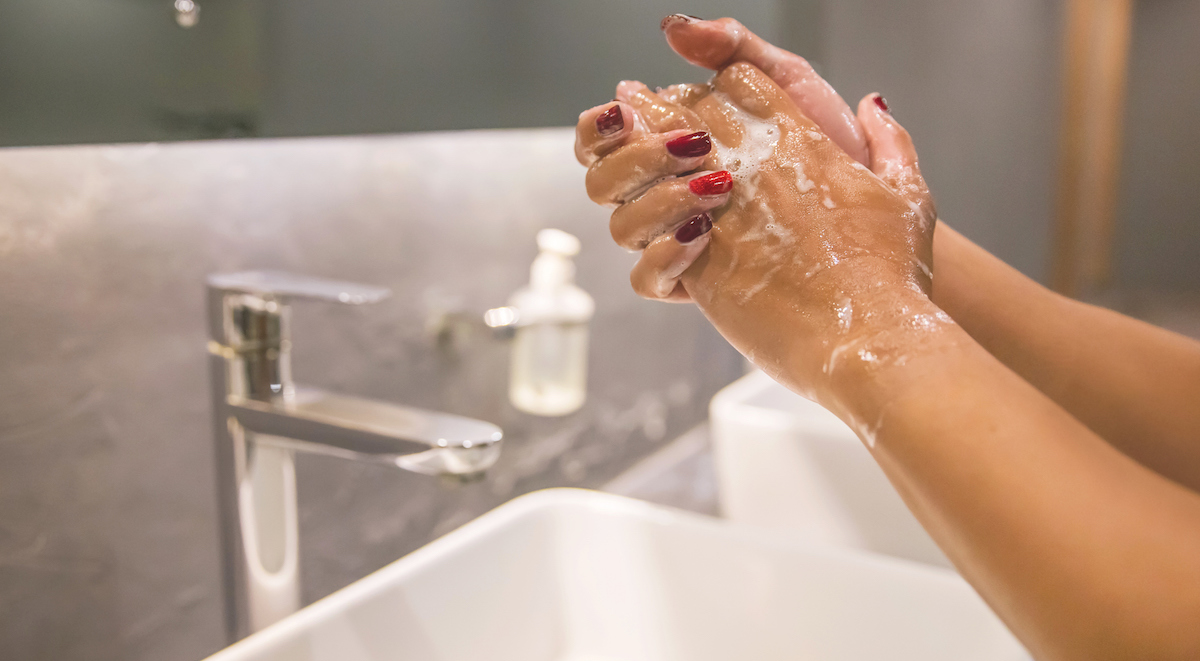<< Back
Back to the Workplace? Has COVID Altered Our Hand-Washing Routine Forever?

March 21, 2022
We’ve just completed two years of hyper-vigilant hand-washing as a frontline defense against COVID-19, but it’s a habit worth keeping as we return to the workplace.
Did you know:
- A significant percentage of foodborne-disease outbreaks are spread by contaminated hands, says the Centers for Disease Control and Prevention.
- Routine hand-washing in the general population could reduce colds and other respiratory illnesses by up to 21 percent.
- Regular hand-washing also could reduce the number of people sickened with diarrhea by 31 percent.
- The use of an alcohol-based hand sanitizer in American classrooms reduced absenteeism due to infection by about 20 percent overall among 16 elementary schools and 6,000 students, according to the CDC.
- And: A study, once cited by the CDC, found only 35 percent of men (and 65 percent of women) washed their hands after using a public restroom.
“We should wash our hands after blowing our nose, sneezing, coughing, touching our mask,” says Dr. Henry Anyimadu, an Infectious Disease Specialist at The Hospital of Central Connecticut in New Britain, “and also after visiting public spaces or caring for someone who is sick.”
Here is what you risk, besides COVD-19, by not washing your hands or interacting with those who don’t:
1. Airborne illnesses: Cold and Flu, Chicken Pox, Meningitis
Respiratory illnesses typically spread when we inhale droplets expelled into the air by an infected person’s cough or sneeze, even by speaking. But these germs also spread by poor hand hygiene.
2. Norovirus: Viral gastroenteritis
Norovirus, which causes viral gastroenteritis, can spread rapidly through a household or office where hand hygiene is not a priority. Diarrhea, nausea, vomiting and stomach pain are common symptoms.
3. E. coli (Escherichia coli)
You can get E. coli by eating tainted meat or touching infected surfaces, but this bacteria also lives in your intestines. Those who do not wash their hands properly after visiting the bathroom — a Michigan State study found that 95 percent of people do not wash their hands sufficiently to kill harmful bacteria — can spread E. coli on everything they touch. If you become infected, it’s not fun: Expect a bout of diarrhea, abdominal cramps and vomiting. Some types of E. coli can also cause urinary tract infections or pneumonia.
4. Salmonella
Eating foods, usually poultry or other animal, contaminated with salmonella is an invitation to some nasty abdominal pain and cramps, diarrhea and fever. Salmonella lives in animal intestines. (It also lives in human intestines.) You can pick it up by touching eggs or uncooked chicken in a supermarket, too.
5. Hepatitis A
Back to the bathroom: The virus that causes Hepatitis A usually spreads when you eat or drink something contaminated with fecal matter. The subsequent liver infection and inflammation is often accompanied by a abdominal discomfort, vomiting, darkened urine, loss of appetite and joint pain.
Soap vs. Sanitizer
“If at all possible, wash your hands with soap and water,” says Dr. Virginia Bieluch, Chief of Infectious Diseases at The Hospital of Central Connecticut, “If you can’t do that, then hand sanitizer is an acceptable alternative.”
Hand sanitizer, which contains ethyl alcohol, was found to be largely ineffective against the flu virus in a recent research study. It was only effective, the scientists revealed, if it was left on the skin for four minutes. Otherwise, mucus that contained the virus protected it against the sanitizer.
Hands should be washed for at least 20 seconds – the time it takes to sing “Happy Birthday” twice, or 20-second choruses from popular tunes like “Raspberry Beret,” “Jolene” and “Karma Chameleon” for variety – with soap and water. Water temperature doesn’t matter as much as your hand washing technique.
The soap, Dr. Bieluch said, removes visible dirt from the hands and attacks viruses like flu and COVID-19. The viruses are encased in a fat coating that soap breaks apart so the virus cannot infect you. In addition, the act of rubbing your soapy hands together sloughs germs off and washes them down the drain.
Make sure you wash both sides of your hands, down to the wrist, and each fingernail and cuticle. Then dry them well, preferably on a paper towel you then throw away. The simple act of rubbing them dry with the paper helps shed any remaining germs.
When it comes to choosing a soap product, opt for liquid or foam. Bacteria can linger on a bar of soap, although rinsing it off before using it can help avoid someone else’s germs.